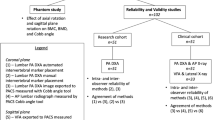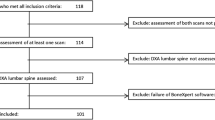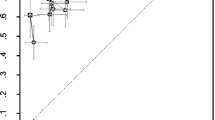Abstract
Introduction
Changes in bone mineral density are used to monitor osteoporosis therapy. To determine whether a change in bone mass is clinically significant, the precision of bone mineral density measurements must be known.
Methods
We therefore measured the impact of vertebral body exclusion on dual energy X-ray absorptiometry (DXA) precision. At one university and one Veterans Affairs DXA center, three radiology technologists each scanned 30 participants twice, with repositioning between scans, to estimate DXA precision. Three International Society for Clinical Densitometry-certified physicians reviewed all lumbar spinal scans to note the presence of focal structural defects. We calculated precision for subsets of vertebrae, and for virtual samples of patients with and without physician-identified vertebral focal structural defects. We graphed the reciprocal of least significant change versus bone area to determine the dependence of precision on interpreted scan area.
Results
Within each sample, greater interpretable bone area improved precision. The contribution of interpreted bone area to precision differed among the samples, ranging from 57 to 94%. Greater population bone mineral density heterogeneity and presence of focal structural defects each decreased precision.
Conclusion
All bone densitometry centers must determine precision using a sample representative of their served populations. Failure to do so may lead to incorrect determination of least significant change. Population heterogeneity, vertebral body exclusion and presence of focal structural defects each decreases precision.


Similar content being viewed by others
References
Kanis JA (1994) Assessment of fracture risk and its application to screening for postmenopausal osteoporosis: synopsis of a WHO report. WHO Study Group. Osteoporos Int 4:368–381
Kanis JA, Johnell O, Oden A, Jonsson B, De Laet C, Dawson A (2000) Risk of hip fracture according to the World Health Organization criteria for osteopenia and osteoporosis. Bone 27:585–590
Marshall D, Johnell O, Wedel H (1996) Meta-analysis of how well measures of bone mineral density predict occurrence of osteoporotic fractures. BMJ 312:1254–1259
Schott AM, Cormier C, Hans D, Favier F, Hausherr E, Dargent-Molina P, Delmas PD, Ribot C, Sebert JL, Breart G, Meunier PJ (1998) How hip and whole-body bone mineral density predict hip fracture in elderly women: the EPIDOS Prospective Study. Osteoporos Int 8:247–254
Hamdy RC, Petak SM, Lenchik L (2002) Which central dual X-ray absorptiometry skeletal sites and regions of interest should be used to determine the diagnosis of osteoporosis? J Clin Densitom 5 [Suppl]:S11–S18
Lenchik L, Kiebzak GM, Blunt BA (2002) What is the role of serial bone mineral density measurements in patient management? J Clin Densitom 5 [Suppl]:S29–S38
Watts NB, Cooper C, Lindsay R, Eastell R, Manhart MD, Barton IP, van Staa TP, Adachi JD (2004) Relationship between changes in bone mineral density and vertebral fracture risk associated with risedronate: greater increases in bone mineral density do not relate to greater decreases in fracture risk. J Clin Densitom 7:255–261
Engelke K, Gluer CC, Genant HK (1995) Factors influencing short-term precision of dual X-ray bone absorptiometry (DXA) of spine and femur. Calcif Tissue Int 56:19–25
Rizzoli R, Slosman D, Bonjour JP (1995) The role of dual energy X-ray absorptiometry of lumbar spine and proximal femur in the diagnosis and follow-up of osteoporosis. Am J Med 98:33S–36S
Blake GM, Fogelman I (1997) Technical principles of dual energy x-ray absorptiometry. Semin Nucl Med 27:210–228
Genant HK, Engelke K, Fuerst T, Gluer CC, Grampp S, Harris ST, Jergas M, Lang T, Lu Y, Majumdar S, Mathur A, Takada M (1996) Noninvasive assessment of bone mineral and structure: state of the art. J Bone Miner Res 11:707–730
Resnick D (1985) Degenerative diseases of the vertebral column. Radiology 156:3–14
Writing Group for the ISCD Position Development Conference (2004) Technical standardization for dual-energy x-ray absorptiometry. J Clin Densitom 7:27–36
Hansen KE, Binkley N, Christian R, Vallarta-Ast N, Krueger D, Drezner MK, Blank RD (2005) Interobserver reproducibility of criteria for vertebral body exclusion. J Bone Miner Res 20:501–508
Gluer CC, Blake G, Lu Y, Blunt BA, Jergas M, Genant HK (1995) Accurate assessment of precision errors: how to measure the reproducibility of bone densitometry techniques. Osteoporos Int 5:262–270
Bonnick SL (1998) The importance of precision in densitometry. In: Bone densitometry in clinical practice: application and interpretation. Humana Press, Totowa, NJ, pp 83–94
Vallarta-Ast N, Krueger D, Binkley N (2002) Densitometric diagnosis of osteoporosis in men: effect of measurement site and normative database. J Clin Densitom 5:383–389
Hansen KE, Vallarta-Ast N, Krueger D, Gangnon R, Drezner MK, Binkley N (2004) Use of the lowest vertebral body T-score to diagnose lumbar osteoporosis in men: is “cherry picking” appropriate? J Clin Densitom 7:376–381
Jones G, Nguyen T, Sambrook PN, Kelly PJ, Eisman JA (1995) A longitudinal study of the effect of spinal degenerative disease on bone density in the elderly. J Rheumatol 22:932–936
Liu G, Peacock M, Eilam O, Dorulla G, Braunstein E, Johnston CC (1997) Effect of osteoarthritis in the lumbar spine and hip on bone mineral density and diagnosis of osteoporosis in elderly men and women. Osteoporos Int 7:564–569
Steiger P, Cummings SR, Black DM, Spencer NE, Genant HK (1992) Age-related decrements in bone mineral density in women over 65. J Bone Miner Res 7:625–632
Cauley JA, Fullman RL, Stone KL, Zmuda JM, Bauer DC, Barrett-Connor E, Ensrud K, Lau EM, Orwoll ES (2005) Factors associated with the lumbar spine and proximal femur bone mineral density in older men. Osteoporos Int 16:1525–1537
Acknowledgements
We thank Jeff Franz for providing us documentation regarding the design of the GE LUNAR database and assistance with conversion of dates from the OLE auto format. RDB gratefully acknowledges support provided by DAMD17-00-1-0071. The US Army Medical Research and Materiel Command, Ft. Detrick, MD, is the awarding and administering acquisition office. The views expressed do not necessarily reflect the position or policy of the US government and no official endorsement should be inferred. This material is based upon work supported in part by the Office of Research and Development, Medical Research Service, Department of Veterans Affairs (VA Merit Award) and was conducted in the Geriatrics, Research, Education and Clinical Center at the William S. Middleton Veterans’ Hospital. This paper is Madison GRECC manuscript 2005-004. KEH gratefully acknowledges support provided by the National Institutes of Health, award K23 AR050995-01. MKD gratefully acknowledges support provided by the National Institutes of Health, awards R01-AR27032-24 and R01-DK65830-01. Funding agencies played no role in any of the following: design and conduct of the study; collection, management, analysis, and interpretation of the data; and preparation, review, or approval of the manuscript. None of the authors has a conflict of interest bearing on the work reported here. RDB had full access to all of the data in the study and takes responsibility for the integrity of the data and the accuracy of the data analysis.
Author information
Authors and Affiliations
Corresponding author
Rights and permissions
About this article
Cite this article
Blank, R.D., Malone, D.G., Christian, R.C. et al. Patient variables impact lumbar spine dual energy X-ray absorptiometry precision. Osteoporos Int 17, 768–774 (2006). https://doi.org/10.1007/s00198-005-0050-5
Received:
Accepted:
Published:
Issue Date:
DOI: https://doi.org/10.1007/s00198-005-0050-5




